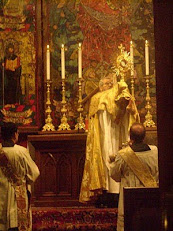“Taste, and touch, and vision, to discern thee fail;
Faith, that comes from hearing, pierces through the veil.
I believe whate’er the Son of God hath told;
What the Truth hath spoken, that for truth I hold.”
These words come from a Eucharistic hymn, glorious poetry, written by the otherwise prosaic Thomas Aquinas in the thirteenth century. With unmatched intellectual brilliance, St. Thomas could explain the theology of the Eucharist in a style that many find dull and unimaginative. But when his heart wrote, his words pierced through the veil in a way that words from the intellect never could. St. Thomas understood that in the Eucharist, he encountered a mystery, and that he truly entered into the precincts of God.
At the hour of Christ’s death upon the cross, the veil in the temple was torn in two. That veil separated the Holy of Holies from the rest of the temple and, at least symbolically, separated the holiness of God from the sinfulness of his creation. At the moment the veil was torn, kairos and chronos met. Eternity entered into time and the way in to the holy precincts was open for all of mankind.
However, the veil still exists in a very real way. We cannot taste or touch or see the risen Lord in the Eucharist species. The bread looks and tastes like bread. The wine looks and tastes like wine. But we believe because, on “the day before he suffered, he took bread into his holy and venerable hands” and he said to his apostles and to us, “this is my body which will be given up for you.”
Today in the Mass we encounter this Eucharistic mystery, 2000 years after Christ stood before his Apostles. We believe that Christ is truly present to us, and although we may not be called to write poetry in the way of St. Thomas, we are brought to our knees before the Truth, and our hearts are moved to sing the words that St. Thomas wrote.
Christ is truly present in the Eucharist, and he is made present because, following in the Apostolic succession, he has called men to be priests at his altar. This month, the Church has been blessed with the ordinations of five men, three of whom were ordained this weekend. They have come to Christ’s holy priesthood through the Personal Ordinariate of the Chair of St. Peter, and they bring with them the beautiful Anglican patrimony that is at the heart of the Ordinariate. But they are Christ’s priests serving Christ’s Church.
I ask your prayers for these men and for the men who will be ordained in the next month. In the years to come, they will stand in persona Christi, making Christ truly present in God’s creation.
Msgr. Jeffrey Steenson
from the Personal Ordinariate of the Chair of St. Peter
Obituary of a very failed Pontificate
-
"Nun khre methusthen kai tina per bian ponen, epei de katthane
Mursilos."Such would have been the reaction of the unchristianised Greeks.
But for us, for t...
7 months ago














No comments:
Post a Comment